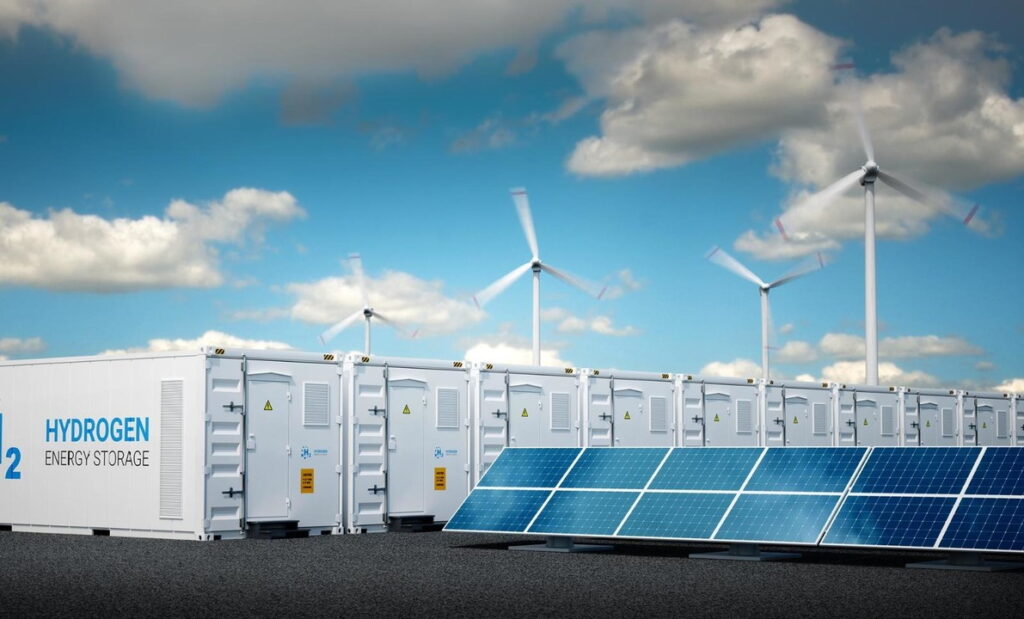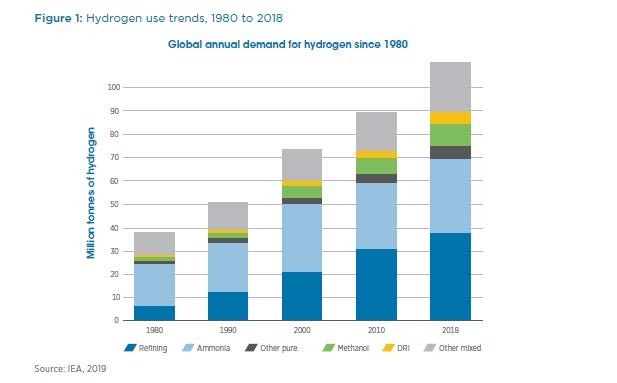
Image credit: https://www.rolandberger.com/zh/Publications/European-cities-bet-on-hydrogen-fuel-cells-to-help-meet-emission-targets.html
Is the image I’ve used, and credited above, a fair representation of our future? Hydrogen proponents, particularly those who want to sell us on the superiority of hydrogen as a transport fuel for fuelcell electric vehicles, would like us to believe it. But what would it take to make such a dream- the generation of hydrogen from renewable electricity, a reality?
How Much Hydrogen Do We Use?
Hydrogen production figures for the world aren’t easy to find. Most of the world’s hydrogen isn’t made as a product and sold. Rather, because hydrogen is so low in density- even as a liquid it’s only 71 kg/m3, and as a gas at 10,000 psig it’s only around 42 kg/m3 – it’s quite the devil to transport. Accordingly, major hydrogen users either build their own hydrogen plant, or build their own facilities next door to a major hydrogen plant that already exists. That makes accounting for H2 production rather more difficult than keeping track of how much gasoline or diesel fuel is used.
The best figures I could find for the breakdown of hydrogen sources at present was quite dated- from the year 2000. Here’s how world hydrogen production broke down in 2000:
Total: 500 billion standard m3/yr- roughly 42,000 kT/yr
48% from natural gas
30% from “oil”, generally meaning internal use in oil/petrochemical refineries
18% from coal
4% by electrolysis
http://www.eolss.net/sample-chapters/c08/e3-13-01-02.pdf
Of that 4% made by electrolysis, a chunk of it is hydrogen made as a by-product in chlor-alkali manufacture, some of which is used for energy, some of which is used for HCl production. So the world’s on-purpose hydrogen electrolyzer capacity in 2000 was quite a bit less than 4% of world hydrogen production. All the rest is made from fossils, and resulted in fossil CO2 emissions to the atmosphere.
To a first approximation, let’s consider the 4% made as a byproduct of chlor-alkali to be made with grid average electricity- which in 2018 was about 33% nonfossil/nonemitting. That puts total world hydrogen production at 96 + 2/3(4) = about 98.7% fossil, without carbon capture. The world’s chlor-alkali plants are likely a little greener than the average grid though, given that these energy-intensive plants, and aluminum smelters too, are often paired with hydro dams. So that figure should be used with caution- though it’s roughly correct.
A more up-to-date figure was provided from this reference: (thanks Ameya Joshi!)
(which is quite an optimistic article about a future “hydrogen economy” and how it could be achieved)
This reference from the Hydrogen Council estimated world H2 production in 2017 to be about 55,000 kT per year- a 30% increase from those 2000 figures. However, since the reference doesn’t give an updated source breakdown of that hydrogen production (that I could easily find, at least!), let’s just set it aside for the moment- knowing the job we have to do just got 30% harder over the past 2 decades or so.
UPDATE: This report from IRENA has more recent and fairly solid data from IEA:
https://www.irena.org/-/media/Files/IRENA/Agency/Publication/2019/Sep/IRENA_Hydrogen_2019.pdf
It includes this figure, which shows hydrogen uses both as the pure gas and in various industrial processes- and these figures are MUCH higher than those in the previous two:
Today, around 120 million tonnes of hydrogen are produced each year, of which two-thirds is pure hydrogen and one-third is in mixture with other gases. This equals 14.4 exajoules (EJ), about 4% of global final energy and non-energy use, according to International Energy Agency (IEA) statistics. Around 95% of all hydrogen is generated from natural gas and coal. Around 5% is generated as a by-product from chlorine production through electrolysis. In the iron and steel industry, coke oven gas also contains a high hydrogen share, some of which is recovered. Currently there is no significant hydrogen production from renewable sources. However, this may change soon.

The IRENA report confirms the ~ 5% figure for byproduct hydrogen from chlor-alkali, and also confirms that almost no hydrogen is currently made from renewable resources. But the amounts of hydrogen used are much, much higher- 120,000 kT (120 megatonnes) per year if you include the hydrogen in syngas used to make methanol, hydrogen used in refineries etc.
Note that in 2019, virtually no hydrogen was used to power vehicles. About 40 MT of H2 was used in refineries- there isn’t data as to how much of that was produced FROM refinery waste streams. At least 1/4 of that, or 10 MT, would still be required even if we swore off the burning of fossil fuels entirely, because we would still need H2 to desulphurize petroleum used in making chemicals, plastics etc.- things we’ll still use petroleum for even once we’ve (hopefully) stopped wasting it for its lowest value use to humankind- as a fuel.
Let’s do a simple calculation to put the current hydrogen use in perspective. Let’s take the 40,000 kT of non-fossil pure H2 production in 2000 (i.e. 1/3 of the total reported by IRENA for 2019), and assume we wanted to make that today using a 70% efficient PEM electrolyzer- 70% on a lower heating value basis i.e. relative to 33 kWh/kg of useful energy in hydrogen. Relative to the higher heating value which includes the heat of condensation of the product water, which is more commonly used to make electrolyzer efficiencies sound good, that’s over 83% efficiency- more or less the system efficiency state of the art at present. Cheaper alkaline electrolyzers run about 55% efficient on an LHV basis, for the whole system, based on quotations I’ve received for pilot plant projects. So: taking a 70% LHV efficiency, we’d need at least 47 kWh of electricity fed to make a kg of hydrogen. Storage? That’s extra- storage at 700 bar, common for transport applications, takes at least another 10%. Let’s ignore storage, and grid losses, for the moment just to keep things simple:
40,000 kT/yr H2 x 47 kWh/kg with unit conversions works out to about 1880 TWh/yr.
For reference, the 2016 worldwide non-hydro renewable electricity production was about 2000 TWh (per the IEA, 2018- 8% of world production of 24,973 TWh).
If we devoted 100% of the solar panels, wind farms and geothermal generators which existed in 2016, to producing nothing but hydrogen- and we had the hydrogen electrolyzer capacity to do that- we could have made the amount of hydrogen we were using in the world in 2000 as pure hydrogen, with a tiny bit to spare- not quite enough to store the resulting hydrogen as a high pressure gas.
We’d only manage to make 1/3 of the total amount of hydrogen we used in 2019. That’s using all the wind and solar we generated in 2016.
To make 40,000 kT/yr of H2 would take a continuous 24/7 electrolyzer capacity of about 214 GW. However, renewables such as wind and solar are intermittent. Taking an availability factor of say 33% as an average of wind and solar, that’s around 650 GW of electrolyzers required to replace the fossil hydrogen we used in the year 2000. For reference a 1.5 MW PEM electrolyzer sold by Hydrogenics fits inside a standard 40 foot shipping container. So we’d need 434,000 shipping containers worth of electrolyzers, to a first guess, to replace the fossil pure H2 production in the year 2000. (Thanks to Dave Smith for finding my error- I’d missed correcting for 24hrs/d in my previous edit!)
http://www.hydrogenics.com/wp-content/uploads/Renewable-Hydrogen-Brochure.pdf
We can certainly quibble about some of my assumptions- these are low precision estimates for sure. Someday the electrolyzer efficiency might get to 80%, and maybe the availability of renewables will increase to 45% if we build more offshore wind and less solar. But the conclusion is still the same: just replacing the H2 we’re making from fossils – much less ALSO replacing gasoline and/or diesel with hydrogen – is a positively staggering task.
Not impossible– but very, very difficult to imagine.
And that’s a disaster really, because if we want to curtail fossil CO2 emissions we’ll need to make ammonia, urea and nitrate from renewable rather than fossil hydrogen – the alternative is to give up eating, as the mass agriculture which actually feeds the human and food animal population is very dependent on these sources of nitrogen fertilizer. Ammonia and its derivatives are a huge user of (fossil) hydrogen and are responsible for something around 2% of global fossil GHG emissions right now. Nowhere nearly as bad as transport, or even electricity generation from fossils today- but still a very substantial problem.
This Dutch article, which Google Translate does a pretty good job of making intelligible in English, does a very thorough job of looking at the economics of hydrogen production from renewable electricity as a way to store the value of renewable electricity which might otherwise be curtailed. To paraphrase, the author says, “I can’t make this look beautiful”…
Can We Use Fossils Instead?
Sure we can- we’re doing it now. But if we want to make hydrogen from fossils without emitting fossil GHGs to the atmosphere, not only do we have to be very careful about methane leakage (most H2 is made from fossil methane), we also have to consider what to do with that CO2. There is, in theory, sufficient deep saline aquifer capacity to stuff all that CO2 into, and about 2/3 of the CO2 produced by a steam methane reformer is at pressure and hence fairly easy to separate out for sequestration. But of course stuffing CO2 into the subsurface takes two things in abundance: energy, and MONEY for high pressure compressors and injection wells and pipelines.
Right now the big use for CO2 collected from burning fossils is as a way to get more fossils out of the ground by means of enhanced oil recovery (EOR). Is that helping? It is, when it offsets the mining of natural CO2 for the same purpose- but it does ultimately result in even more fossil CO2 in the atmosphere.
There’s another way: it is possible by a variety of means to convert methane not to CO2 and H2, but rather to H2 and carbon. One of my company’s customers, Monolith Materials, is doing this right now, and it’s a spectacularly good idea as a way to make carbon black- useful in all sorts of applications- while also making hydrogen. Their website has lovely pictures of their pilot plant which I had a hand in designing and building:
https://monolithmaterials.com/
Of course Monolith would freely admit that if they had to bury their carbon black instead of selling it as their primary product, they could never make a business out of selling just the resulting fossil CO2 emission-free hydrogen.
Other firms are planning to do the same with graphite being the desired product.
A little math here is very instructive. Let’s say 60 megatonnes per year of H2 are still needed after we stop fossil burning deliberately, i.e. 1/2 of how much we use today. If we were to find a magical way to do endothermic pyrolysis of methane without spending ANY ENERGY- i.e. this is impossibly optimistic- then we’d need to use 60 *16/4 = 240 megatonnes of methane and produce 180 megatonnes of carbon per year. For reference, the world markets for carbon black and graphite are 14 and 1.5 megatonnes per year total. We’d be making, and burying at cost, rather than using, an awful lot of artificial coal if that was our intended way to make hydrogen!
All in all, methane pyrolysis, done right, is a nice but very PARTIAL solution- one which might make money making a product with the production of nonemitting hydrogen being “gravy”. But it’s not a scalable solution to be a significant source of nonemitting H2 relative to how much we use now, or might use in the future once we stop burning fossils as fuels- much less for new inefficient uses.
What About Biomass?
There are other good ideas out there. We can make some hydrogen by gasifying biomass, or by reforming methane produced from waste biomass by anaerobic digestion. It is a little challenging and fairly lossy, as H2 for fuelcells needs to be very pure- less than 10 ppm total in CO and CO2, which is a stretch when you’re starting with a biogas stream which is 500,000 ppm CO2. Using biomass will help reduce the challenge of de-fossilizing H2 production. In fact, reforming biogas is cheaper right now than electrolyzers as a source of renewable hydrogen, and hence that is apparently the major source currently of the 1/3 of hydrogen for use in fuelcell vehicle refuelling in California by mandate. The other 2/3 of FCEV refuelling H2 is made from fossils, and is much cheaper- even though California has a modest carbon pricing scheme. Retail, California H2 is $15/kg – $75 to drive a Toyota Mirai 320 miles. Not a cheap fuel…
Beware the lure of biomass however. Read www.withouthotair.com to see just how much energy we use, and how much we could make from biomass even if economics were no option. Biomass-derived fuels are again, a nice but very partial solution if done right, and a source of environmental and social harm if done wrong. And when they’re used, using them directly as fuels makes more sense than converting part of their energy to another fuel unless that is absolutely necessary. One place this IS necessary is to fuel jet aircraft. Hydrogen is possible for that purpose, but is a very impractical option for a mode of transport that really cares about energy density per unit weight AND volume because it has to push that volume through the air at high speed.
Beware the Lure of Renewable Hydrogen
I’ll leave you with this caution: these facts aren’t, or shouldn’t be, unknown to even the most ardent fuelcell vehicle supporter. They tend to heap on the criticism of battery electric vehicles because we still make a lot of our electricity worldwide from fossils too. However, the proportion of electricity made by low GHG emission sources is positively HUGE compared to the proportion of hydrogen production from non-emitting resources right now. And because battery electric vehicles are over 3x as energy efficient as FCEVs, using that electricity directly rather than indirectly via the lossy hydrogen middleman will mean that the challenge of building out renewable generation capacity will be 1/3 as great if we go this route for cars and light trucks- where batteries are a fully feasible alternative to hydrogen.
Consider the possibility that something else is going on: since hydrogen right now is overwhelmingly made from fossils, is it likely that fuelcell vehicles would actually be fuelled with renewable hydrogen? Or is this a “bait and switch” scam to sell you fossil fuels in another form? Some H2 advocates are more honest about this than others.
My articles about hydrogen fuelcell vehicles, and why I think they’re a dead end for cars and light trucks:
https://www.linkedin.com/pulse/hydrogen-fuelcell-vehicle-great-idea-theory-paul-martin/
https://www.linkedin.com/pulse/mirai-fcev-vs-model-3-bev-paul-martin/
Disclaimer: everything in this article is my own opinion. I provide references where possible, as links so they’re easy to check. But I’m human, and hence prone to error. I encourage anyone who can show where my calculations are incorrect, with references, to let me know and I’ll edit my article promptly.
